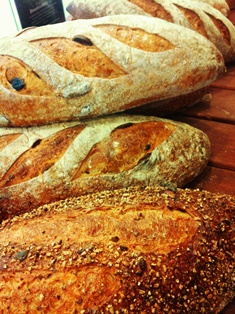Ancient Grains - what they are and why they matter

There's a lot of interest in ancient grains – spelt, quinoa, barley, black rice, kamut and buckwheat - these days and with good reason. Ancient grains bring the romance of rustic old worlds into our kitchens. They add new interesting flavours to our meals and put us in touch with a slower more natural way of life. In this post I'll tell you what they are and why they're enjoying such a revival today.
What is an ancient grain?
For many years archaeologists have reported finding the remains of grains and grain stores in ancient sites. For example researchers in China found the remains of charred wheat and millet in Yunnan that are thought to be nearly 4,000 years old!
However, the term ancient grain doesn't mean just a 4,000 year old grain seed. It refers to the ancient types of grains that have only recently been 'discovered' by the West. But these heritage grains have been grown by different communities the world over as they began settling in one place and forsaking the nomadic life. These include quinoa, chia, amaranth, millet, wild rice and ancient forms of wheat such as spelt, farro (also known as emmer) and Kamut™.
For example, rather than modern wheats bred for rapid growth and easier milling, many folk are seeking out Kamut or Khorasan, an obscure wheat which was 'forgotten' for centuries and only kept alive as an optional side crop sown by small farmers in Turkey and Egypt.
Another example, barley and oats which were once the major grains of Europe but were sidelined after the 1800s when faster-growing higher-yielding wheats took over. Now barley is used mainly for malting (for beer and whiskey) while oats only feature as a winter porridge. Or in the odd crumble topping!
You've probably heard of some of them or seen them around health food shops, farmers'/organic markets and added to artisan breads.
They're rapidly becoming more popular and mainstream and these days you can often find pasta, noodles and other products in the health food section of your local supermarket chain.
Why are ancient grains important?
Most ancient grains have a delicious chewy texture, are grown in an eco-friendly way and many provide useful grain alternatives for those searching for gluten-free and/or wheat-free items. What's more, they are usually cooked in the "whole grain" form which is nutritionally much more beneficial than the over processed and refined modern grain products. Many are grown organically which is better for the soil and environment.
Often described as "super grains", ancient grains offer us much in the way of natural nutrition and positive health benefits.
Nutritional advantages

These heritage grains boast more fibre and can be a richer source of vitamins and minerals but this is not a hard-and-fast statement – often it will depend on the variety, the soil and conditions under which they were grown.
However, some do shine for specific nutrients. For example barley is an outstanding source of selenium; teff and spelt hit the high values for manganese; chia scores over twice as much fibre as other grains; oats have an impressive level of thiamin.
Ancient grains tend to be less refined, eaten as whole berries or grits (cracked) or rolled, so you get the whole grain advantage. Whole grains come with their natural bran and germ, giving you the complete package of nutrition. They make you chew more too which is a good thing in our world of soft over-refined fare!
Many are grown organically eg to qualify for the Kamut™ description, the wheat must be organic, which is better for the soil and environment.
Research shows that people who eat whole grains generally have lower cholesterol levels and are less likely to develop diabetes and certain cancers, most notably breast and colon cancers. Several studies have also linked eating whole grains to a low risk of high blood pressure.
Types of grains
Here's the list of the 23 grains and grain products you'll find out about in the book below:
Amaranth
Barley
Buckwheat
Chia (really a seed!)
Corn (polenta, cornmeal, corn on the cob)
Millet
Oats
Quinoa
Rice (brown, black, red)
Rye
Sorghum
Teff
Wheats, ancient (farro/emmer, Kamut, spelt)
Wheat Products (wheat berries aka wheat kernels, bulgur, couscous)
Wild rice
Note: we cover three types of corn and wheats as well as three varieties of rice.
Grains vs pseudo-grains
Traditionally eight grains are considered cereals: wheat, rice, corn, oats, rye, barley, millet and sorghum. Spelt, farro or emmer and Kamut are types of wheat.
Buckwheat, wild rice, amaranth, chia and quinoa are technically not true grains but are included here as they are grown and cooked in the same way.
Downloads / Fact Sheets
Read my article written for Sunday Life magazine 2013.


